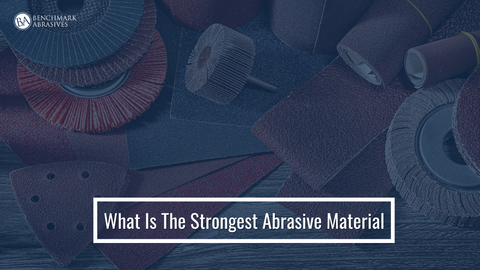
What Is The Strongest Abrasive Material?

Metal workpieces frequently have impurities or flaws that develop organically or as a result of different manufacturing or processing processes. These flaws may make it harder to apply coatings or carry out other necessary steps, which would lower the quality of the final product.
Materials are efficiently removed by abrasive blasting, which also gets the substrate's surface ready for further production stages. To obtain the desired finish, high-pressure water containing abrasives is blasted away, along with chemicals, oil, grease, and other materials.
For the blasting process, a wide variety of media or abrasive materials are available, each with unique benefits and drawbacks.
WHAT KINDS OF ABRASIVE MEDIA ARE THERE?
The most popular abrasive media types are examined in further detail below, along with a synopsis and typical surface finishing applications:
1. GLASS BEADS
When it comes to blasting media, glass isn't as aggressive as materials like silicon carbide or steel shot. Still, it's an excellent option for applications that need a brighter, softer finish. Applications using stainless steel are a good fit for it. Additionally, recyclable are glass beads.
2. ALUMINIUM OXIDE
The exceptional strength and hardness of aluminum oxide are its defining characteristics. It is used as a blasting media in industrial settings, as a raw material in refractories, and on anti-slip surfaces for abrasive pressure blasting of practically any kind of substrate, including steel, granite, marble, and glass; aluminum oxide abrasives are used. It is used to prepare surfaces before painting or coating them because of its profound etching capacity.
3. PLASTICS
Crushed urea, polyester, or acrylic are the materials used to make plastic abrasives, a dry thermoset cleaning medium. A range of particle sizes and hardnesses are offered for each variation. The ideal abrasive material for cleaning molds, blasting plastic parts, or other applications where substrate removal is prohibited is widely thought to be plastic. Plastic media blasting is frequently used in the automobile, aircraft, watercraft, electronics, and industrial applications industries.
4. SILICON CARBIDE
Silicon carbide is the ideal option for your most challenging surface finishing applications because it is the hardest abrasive blasting material currently on the market. It comes in a range of purities and colors. Its main uses include general-purpose heavy-duty blast-cutting applications, glass etching, lapping, polishing, and bonding abrasive tools.
5. STEEL SHOT AND GRIT
Because of their excellent recyclability and hardness, steel abrasives are a more affordable option than other abrasives. It is helpful for peening (hardening) applications, efficiently removing impurities from a range of surfaces, and texturizing surfaces to provide optimal adhesion to a final coating. The appropriate size, hardness, and shape greatly influence the proper medium selection.
6. STAR BLAST
An excellent all-purpose blasting abrasive, Starblast is a mind-loose blend of fine and coarse staurolite sands with deficient silica levels. With its low dust level and ability to remove scale and rust from steel surfaces, it is ideal for improving visibility.
7. WALNUT SHELLS
A complex, naturally occurring substance formed from crushed walnut shells is called walnut shell abrasives. This is the most durable soft abrasive, coming in multiple sizes, ideal for blast cleaning and polishing soft surfaces that more aggressive abrasives can harm. Polishing soft metals, fiberglass, wood, plastic, and stone is a common application. Moreover, it can be applied to tumble operations to polish jewelry and diamonds.
8. CORN COBS
A corn cob's dense, woody ring is crushed into different grit sizes to create a corn cob abrasive, a granular abrasive. Because it is the softer of the naturally occurring abrasives, it is perfect for applications involving cleaning, deburring, burnishing, and de-flashing. Jewelry, cutlery, motor parts, fiberglass, and the removal of graffiti and other dirt from wood, brick, and stone are examples of typical businesses.
THE CRITERIA FOR EVALUATION
When choosing one of these materials, keep in mind that each one performs differently depending on these factors:
- HARDNESS: The Mohs Hardness Scale uses a rating system of 1 to 10 to assess a material's ability to withstand scratches. When preparing soft substrates, a higher rating indicates that the media is more likely to scrape the surface.
- SURFACE PROFILE: The profile of abrasive leaves on a material's surface is determined by its size, shape, hardness, and density. An etch of nil, low, medium, or high can be the outcome.
- SURFACE REMOVAL: To make sure the finished product satisfies the project's requirements, you must determine how much of the substrate's surface the abrasive media will remove before selecting one.
- RECYCLING: If cutting expenses is a priority for your company, think about recycling and reusing the material that has been subjected to abrasive media blasting.
- WORKING SPEED: You can finish the abrasive media blasting process more quickly with certain materials than with others.
- BULK DENSITY: The cleaning rate of an abrasive and the surface profile it leaves on the substrate are affected by its density, which is expressed in pounds per cubic foot.



































































